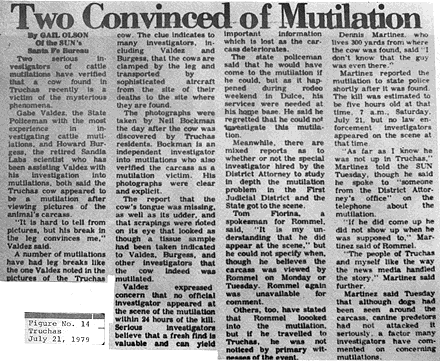
Two serious investigators of cattle mutilations have verified that a cow found in Truchas recently is a victim of the mysterious phenomena.
Gabe Valdez, the State Policeman with the most experience in investigating cattle mutilations, and Howard Burgess, the retired Sandia Labs scientist who has been assisting Valdez with his investigation into mutilations, both said the Truchas cow appeared to be a mutilation after viewing pictures of the animal's carcass.
"It is hard to tell from pictures, but his break in the leg convinces me," Valdez said.
A number of mutilations have had leg breaks like the one Valdez noted in the pictures of the Truchas cow. The clue indicates to many investigators, including Valdez and Burgess, that the cows are clamped by the leg and sophisticated aircraft from the site of their deaths to the site where they are found.
The photographs were taken by Neil Bockman the day after the cow was discovered by Truchas residents. Bockman is an independent investigator into mutilations who also verified the carcass as a mutilation victim. His photographs were clear and explicit.
The report that the cow's tongue was missing, as well as its udder, and that scrapings were noted on its eye that looked as though a tissue sample had been taken indicated to Valdez, Burgess, and other investigators that the cow indeed was mutilated.
Valdez expressed concern that non official investigator appeared at the scene of the mutilation within 24 hours of the kill. Serious investigators believe that a fresh find is valuable and can yield important information which is lost as the carcass deteriorates.
The state policeman said that he would have come to the mutilation if he could, but as it happened during rodeo weekend in Dulce, his services were needed at his home base. He said he regretted that he could not investigate this mutilation.
Meanwhile, there are mixed reports as to whether or not the special investigator hired by the District Attorney to study in depth the mutilation problem in the First Judicial District and the State got to the scene.
Tom Florina, a spokesman for Rommel, said, "It is my understanding that he did appear at the scene," but he could not specify when, though he believes the carcass was viewed by Rommel on Monday or Tuesday. Rommel again was unavailable for comment.
Others, too, have stated that Rommel looked into the mutilation, but if he travelled to Truchas, he was not noticed by primary witnesses of the event.
Dennis Martinez, who lives 300 yards from where the cow was found, said "I don't know that the guy was even there."
Martinez reported the mutilation to state police shortly after it was found. The kill was estimated to be five hours old at that time, 7 a.m., Saturday, July 21, but no law enforcement investigators appeared on the scene at that time.
"As far as I know he was not up in Truchas," Martinez told the Sun Tuesday, though he said he spoke to "someone from the District Attorney's office" on the telephone about the mutilation.
"If he did come up he did not show up when he was supposed to," Martinez said of Rommel.
"The people of Truchas and myself like the way the news media handled the story," Martinez said further.
Martinez said Tuesday that although dogs had been seen around the carcass, canine predators had not attacked it seriously, a factor many investigators have commented on concerning mutilations.